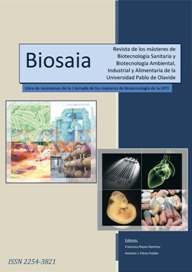Characterization of flagellar-specific sigma factor FliA in Sphingopyxis granuli TFA
Palabras clave:
sigma factor, flagella, Sphingopyxis granuli TFAResumen
Motivation: Sigma factors are RNA polymerase subunits which play a crucial role in the transcriptional regulation of bacterial gene expression. These dissociable proteins bind to RNA polymerase controlling promoter recognition and thus, gene expression (Francez-charlot et al., 2015). Previous studies in Alphaproteobacteria identified a sigma factor FliA as a key transcriptional regulator of chemotaxis and flagella biogenesis by controlling the expression of genes involved in flagellin biosynthesis, an essential structural protein which forms flagella filament (Maruyama et al., 2015). Sphingopyxis granuli TFA is a Gram-Negative Alphaproteobacteria very interesting since is one of the few strains able to grow on the organic solvent tetralin as a sole carbon and energy source and able to grow respiring nitrate under anaerobic conditions (García-Romero et al., 2016). The aim of this study is to construct and phenotypically characterize a fliA deletion mutant that help us to elucidate the function of FliA sigma factor and thus, the hierarchy of transcriptional regulation of flagellar genes, in Sphingopyxis granuli TFA.
Methods: A fliA deletion mutant is being constructed using a DNA-recombination method based on a double-strand break caused by SceI nuclease. Firstly, flanking regions of fliA gene must be cloned in a multiple cloning site (MCS) of a non-replicative vector. At the same time, this MCS is flanked by two SceI target sites. Once this integrative vector is integrated into the chromosome and selected in wild-type TFA, a broad host range vector including SceI gene downstream of an inducible promoter must be introduced. A double-strand break is caused in the chromosome after the induction of SceI nuclease by 3-methylbenzoate and DNA will be repaired causing FliA gene deletion.
Once fliA deletion mutant is constructed, a phenotypic characterization will be performed. In addition, both semi-quantitative PCR and Q-PCR assays will be used in order to confirm which genes are regulated by FliA in Sphingopyxis granuli TFA.





